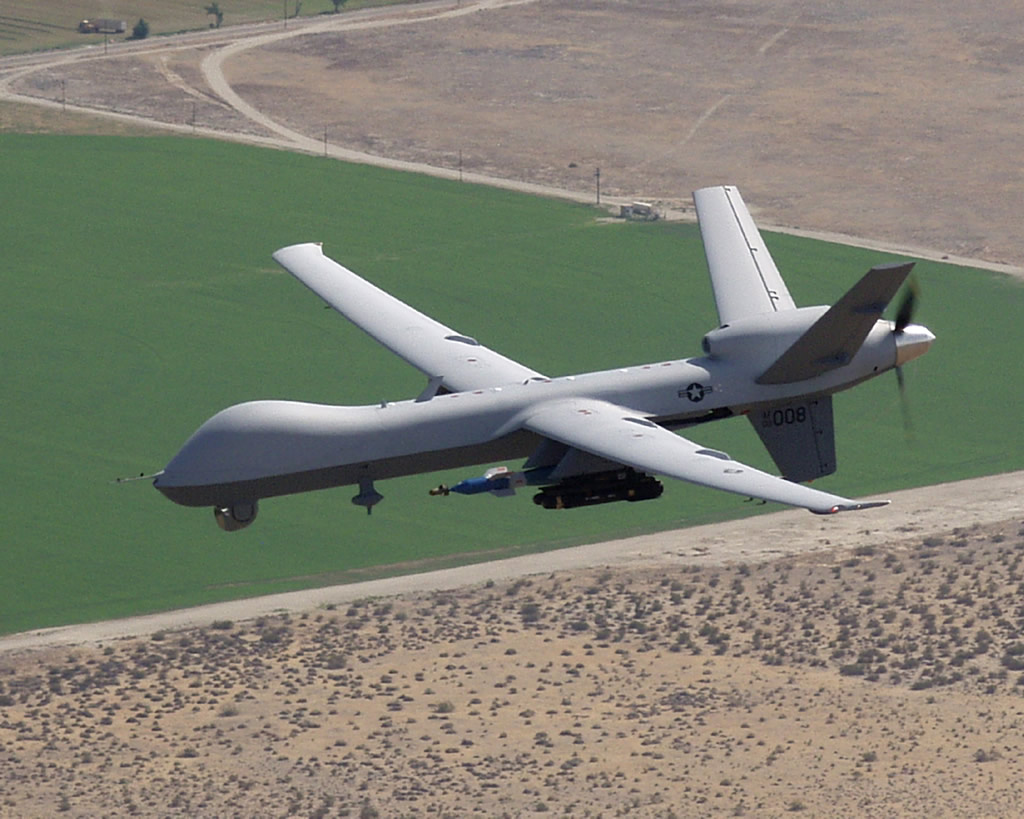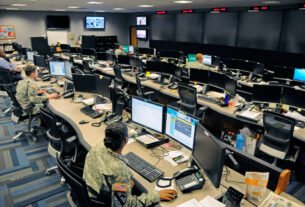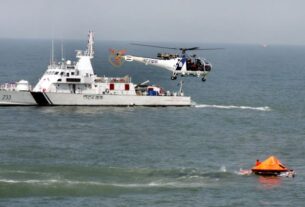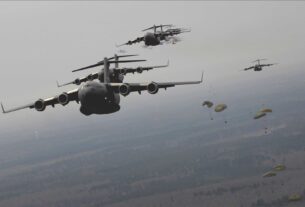Unmanned Combat Aerial Vehicles
Air superiority is an essential military mission, and will continue to be so for the foreseeable future. Control of the air is not an end of its own, but rather it provides the flexibility and freedom of action central to a full range of military capabilities.
From its earliest days in the skies over the battlefields, air superiority has proven itself as an objective of primary importance for all military forces. The maneuverability and lethality of the air-superiority fighters has advanced quickly as technology has played an important part in the evolution of air combat tactics.
For decades, success in dogfights was a direct result of aircraft designed specifically to enhance aerodynamic performance, size and visibility. As advanced technology changed tactics to allow for the potential to employ radar missiles beyond visual ranges, the design requirements for air-superiority fighters changed also; high altitude, high-speed interceptors with avionics that allowed for long- range target detection, identification, and destruction became desired. After combat experience proved that interceptors and bombers alone could not secure the skies, a new breed of air-superiority fighter was born. Air-superiority fighters today are designed for extreme maneuverability to ensure success in a close engagement, and stability as platforms that combine superior detection systems, weapons and stealth.
Rapid advances in technology are enabling more and more capability to be placed on smaller airframes. The military role of unmanned aerial vehicles is growing at unprecedented rates and its success in Afghanistan and Iraq war has proved its mantle when it comes to getting accurate and timely ISR information.
However, with the changing military scenario and increasing demand of immediate response in battlefield, world is experiencing a rise in the use of unmanned combat aerial vehicles (UCAV), which is an aircraft without an on-board human pilot which is able to attack targets and is recoverable and reusable.
Air superiority
It is assumed that an air-superiority UCAV should be feasible by the year 2025 and that it should provide an effective and affordable alternative to manned air-superiority fighters.
UCAVs are an emerging technology that has the potential to revolutionize air warfare. While the 5th generation of combat planes today is the pinnacle of military aviation, UCAVs present paradigms that can supplement them.
The drawback of most existing reconnaissance and surveillance UAVs is that these are slow and non stealthy vehicles-a byproduct of the aerodynamically very efficient high aspect ratio unswept wing design needed for great endurance. The direct consequence of this is that reconnaissance and surveillance UAVs can only make use of altitude to improve survivability-a dubious advantage in an era of long range SAMs and hi-tech interceptors.
High altitude might improve survivability and slant range, but exposes a high flying UAV to the same weather and terrain elevation related problems experienced by satellites. Cloud will blind thermal imaging and daylight television cameras very effectively, forcing the use of synthetic aperture mapping radar. The latter, despite picture resolution now in inches, is also not without its limitations, since terrain shadowing at shallow slant angles can obscure many targets. Often there is no substitute for a close in photograph or video frame.
Low altitude penetration is not an option for a high altitude long endurance optimized UAV – poor gust resistance, low speed and large radar signature would all impair survivability.
As the capabilities grow for all types of UAV, nations continue to subsidize their research and development leading to further advances enabling them to perform a multitude of missions. UAV no longer only perform intelligence, surveillance, and reconnaissance (ISR) missions, although this still remains their predominant type. Their roles have expanded to areas including electronic attack (EA), strike missions, suppression and/or destruction of enemy air defense (SEAD/DEAD), network node or communications relay, combat search and rescue (CSAR), and derivations of these themes.
The main objective of using a UCAV is to minimize risk and cost without losing the ability to achieve the mission. UCAVs can operate with higher degrees of autonomy, conducting missions with little controller influence following the input of mission information. The weapons employed from a UCAV are generally conventional air-to-ground guided munitions. In the future, micro-munitions, Directed Energy Weapons and weapons for air-to-air combat could be used from UCAVs.
A UCAV is considered as part of a system of systems requiring full operational support services. Each system is composed of a number of aerial vehicles and a ground control station. Like manned aircraft, they are formed into squadrons of several systems and accompanied by ground support equipment, spare parts/supply and maintenance personnel. A single aerial combat vehicle consists of an advanced airframe and its onboard suite of ûight controls, weapons, guidance packages, survivability features, perhaps aerial refueling component and a propulsion system.
Operating bases require facilities and special mapping plans for UCAV ground operations. The UCAV systems exploit the design and operational freedoms of relocating the pilot outside of the vehicle to enable a new paradigm in aircraft affordability while maintaining the rationale, judgment and moral qualities of the human operator.
The UCAVs have been very vital to US operations in Afghanistan and Pakistan. According to a New America Foundation report, in 2012 alone, the US forces killed between 222 and 349 militants in the course of 48 UCAV attacks in Pakistan alone. The General Atomics MQ-1 Predator, later upgraded with AGM-114 Hellûre, has been used for combat in countries like Afghanistan, Pakistan, Bosnia, Serbia, Iraq, Yemen, Libya and Somalia.
UCAV designs enjoy a freedom of design unmatched by manned aircraft. The elimination of a cockpit and the requirement for internal weapons bays allow the engineers to create lift, minimize drag, reduce weight, and streamline inlet air flows, all of which contribute to an extremely efficient flying vehicle possessing a low radar cross section (RCS).
Advantages
UCAVs have many advantages and provide significant operational benefits. It is a common argument that unmanned aircraft are better suited to ‘4D’ tasks: the dull, dirty, dangerous and deep. The dull aspect refers repetitive missions or missions that require persistence, and so are better suited to autonomous systems than humans. ‘Dirty’ refers to environments in which there are nuclear, biological and chemical threats. ‘Dangerous’ tasks are those in which there is a high risk to the aircraft and aircrew. ‘Deep’ tasks are those that are beyond the range of current manned aircraft.
UCAVs provide highly flexible operational capabilities and so can be used in a range of different roles. There are a number of types of UCAVs, with quite different characteristics, ranging from low-speed armed unmanned air vehicles (UAVs) whose primary role is intelligence gathering, to high speed, stealthy and agile strike UCAVs.
UCAVs have the potential to be more cost-effective than manned aircraft. In general, they are smaller, simpler aircraft, which reduces the design and manufacture costs. In addition, the training, operation and support costs for a UCAV are predicted to be lower than manned aircraft. Armed ISR UAVs are most suitable for the attack of mobile, time-sensitive, ground targets. Examples of time sensitive targets may be enemy leadership personnel in an urban environment or mobile air defence assets. These missions require rapid target acquisition, identification and engagement. High accuracy is also essential to minimize collateral damage. For time-sensitive targets, the time from detection to strike will need to be extremely short; the platform will need to be close-in and possibly even over the target area. This will most commonly occur with platforms that are able to loiter and search above potential target areas.
With their high endurance and ability to loiter, these UCAVs are also able to provide protection to ground forces on the front line. The command and control of the UCAV would have to be flexible, allowing ground troops to request engagements as they require. This role is most suitable for UCAVs because of their long endurance and persistence capabilities.
Armed ISR platforms may also have maritime applications. UAVs are already used in ISR roles for escort operations, sea-lane and convoy protection and the protection of high-value and secure installations. In the future, it is possible that these systems could also prosecute maritime targets.
There are several roles in which the presence of these UCAVs may provide operational benefits without firing its weapons. For example, the presence of an airborne UCAV may act as deterrent, protecting assets, such as convoys, from attack without the need to use its weapons.
The critical function of a UCAV is the prosecution of targets, and this area presents the primary opportunities to the guided weapons industry. The applicable weapon technologies depend on the type of UCAV system and the role it will be performing. The current opportunities focus on arming UCAVs with conventional guided missiles and jamming systems. In the future, the employment of micro-munitions, E-bombs and Directed Energy Weapons from UCAVs will provide further opportunities to the guided weapons industry.
Initial attempts
The United States military has a long history of involvement with UAVs. The first attempt at employing a UAV was the Sperry N-9 Flying Bomb in 1918. Since that time, UAVs have had active reconnaissance roles in many American conflicts: Vietnam, Operation Desert Storm, Operation Deliberate Force, Operation Allied Force, And Operation Enduring Freedom, to name just a few.
The history of military drones or unmanned combat aerial vehicles (UCAV) is probably as long as the history of aircrafts. Military leaders always dreamed of reaching their enemies from distance, especially when there was a real opportunity of avoiding human casualties. As might been expected, the US military sector led in these types of engagements and was the first to apply the idea of aerial military surveillance (as far as in during the Civil War), but other countries are also following.
As early as 1917, the United States dedicated significant resources, over $200,000, to create a remotely piloted flying bomb. While not officially designated a UAV, this desire to achieve mission success without risk to human life initiated the progression toward today’s UCAVs. The first of which was developed for Israel through the Big Safari management and acquisition program. In an effort to aid the Israelis, in their efforts to destroy SAM and AAA sites along the west bank of the Suez Canal, the armed UAV concept was developed and tested.
Over the next two decades, advancements in computer automation, flight control systems, satellite communications, and weapon systems have enabled unmanned aircraft to demonstrate combat effectiveness similar to today’s strike fighter aircraft.
In particular for UCAV, GPS guidance technology has significantly improved combat ability of the weapons intended for use. These abilities are best demonstrated by the Global Hawk’s trans-Pacific flight of 2001 and the X-45A’s successfully delivery of a small smart bomb, to within feet of the intended target.
The UCAV concept covers a wide range of systems with many different characteristics. UCAVs can be categorized into Armed Intelligence, Surveillance and Reconnaissance (ISR) UAVs, large, advanced, stealthy UCAVs and small, agile, expendable UCAVs.
Armed Intelligence, Surveillance and Reconnaissance (ISR) unmanned air vehicles are the first type of UCAV. These UCAVs are primarily used in ISR roles, but are armed to provide lethal effects if required. The primary characteristic of these UCAVs is persistence. They operate at medium or high altitudes, and are low speed and long endurance systems. They are unlikely to operate in extremely high risk environments due to their relatively high radar signature, low speed and low agility. Examples of this type of UCAV are the MQ-1B Predator and MQ-9 Reaper. Armed ISR UAVs are most suitable for the attack of mobile, time-sensitive, ground targets. With their high endurance and ability to loiter, these UCAVs are also able to provide protection to ground forces on the front line. The command and control of the UCAV would have to be flexible, allowing ground troops to request engagements as they require.
Large, advanced, stealthy UCAVs are a second type of UCAV. These are highly sophisticated systems which are designed to be deep penetrating and stealthy strike aircraft. Typically these aircraft will be similar in size to existing fighter aircraft. In addition, they will be highly agile and supersonic, but with limited persistence. Number of large, advanced, stealthy UCAV are under development as technology demonstrator programs, but operational systems are unlikely in the short-term. In the future, these systems could be fighter aircraft, performing air-to-air combat tasks in order to gain control of the airspace. This type of UCAV can be used to perform long-range bombing campaigns against fixed ground targets. In this role, the UCAV may be used as a cost-effective alternative to piloted bombers. To conduct missions, the UCAV can follow predefined long-range flight paths, planned to avoid air defence assets. A carrier-based version of this type of UCAV could be used to increase naval reach, conducting sea-based surveillance, naval strike and the suppression of enemy air defence missions.
In the long-term, this type of UCAV could be used to gain control of the airspace. These systems will be operating in very hostile environments in the quest for Air Superiority and Air Supremacy.
Small, agile expendable UCAVs, with airframes similar to large, long-range cruise missiles, are potentially a third type of UCAV. They would be medium speed and agile and would be able to operate at low altitude, even executing terrain-following routes. They would be much smaller than other UCAVs, and so hard to detect and, unlike a cruise missile, they would be reusable. If such a system could be developed at low-cost, they could operate in extremely hostile environments as they would be expendable.
Small, agile, expendable UCAVs would be suitable for penetrating air defence systems and could deliver small weapons from close-range against an array of ground targets. This system could provide a broad spectrum of operational capabilities, including specialist bombing missions against fixed ground targets, the suppression and destruction of enemy air defence and the attack of time sensitive and mobile ground targets. In the future, very advanced systems also could be used for air-to-air engagements to gain control of the airspace.
Large, advanced, stealthy UCAVs will be very high value assets, and so will stand-off to ensure survivability and will require complex stand-off weaponry. They will have much higher payload capacities than armed ISR UAVs, but most will have internal weapon bays to improve the stealth characteristics of the airframe. Further opportunities may also be provided by the development of small, agile, expendable UCAVs. These systems could carry a payload of small conventional munitions for the prosecution of ground targets. It may be, however, that conventional air-to-ground cruise missile for UCAVs may be superseded by smaller missiles that are classed as micro-munitions.
UCAVs offer greater range, maneuverability and payload capacity than manned strike aircraft because they can dispense with life-support systems, flight controls, ejection seat, even the cockpit. On the flipside, the response time of a UCAV’s flying control surfaces is much longer than that of a manned aircraft due to the distance between the operator and the airborne machine. At present, UCAVs are remotely piloted by a person who is generally on the ground. Alternatively, the operator could be located on an airborne aircraft in the vicinity. In the near future, UCAVs will also be capable of fully autonomous missions with pre-programmed routes and target details, decision making ability, and adequate means of defence against air and ground opposition.
Human operators can always be put in the loop where necessary, but a UCAV can easily handle many tasks autonomously. The UCAV can take off, fly a designated route, destroy targets and awaiting instruction or flying back to base, dodging missiles and being fully aware of many factors pilots often forget-being aware of status of weapons, fuel supply, location of enemies and friendly forces, ground units and whether weapons doors are open or closed. It can think of all this simultaneously and do so without mistakes, under any amount of stress, either physical or sensory.
UCAVs can go into combat disregarding whether they need to come back or not. The biggest advantage with UCAVs is their cost effectiveness. UCAVs can be manufactured and operated at a tiny fraction of the cost of manned fighters. Quality pilots are a rare commodity and are hard to find, train and keep operationally ready. They also take a considerable amount of lead-time to train effectively.
After all, if the UCAV is not endangering a pilot’s life, does not fly frequently and is cheap to manufacture, they need not be as durable. UCAVs need only be flown during wartime or during high tension periods. This means that their subsystems can be built more cheaply, a key cost element particularly in combat aircraft engine technology.
The advent of small, lower-power jamming systems has provided the potential for UCAV-based airborne electronic attack capabilities, which could be used to suppress radar and communication systems. The power requirements for a UCAV-mounted system are significantly lower than those on piloted aircraft as a UCAV can operate close-in to targets. This has driven down the size, weight and cost of jamming units.
In today’s systems, all airborne data captured by the UCAV is relayed to the ground, where is it processed and interpreted. Once the necessary decisions have been made, control demands are then uplinked to the airborne platform. This process places huge demands on data link rates, in particular when air-to-ground video transmission is involved. These problems of bandwidth and spectrum constraints must be addressed as the operation of UCAVs becomes more widespread.
The UCAV market is growing across the world. The significant investment by the world’s leading nations demonstrates a commitment to UCAV technologies and heir future use. As a result, UCAVs provide a new growth market, which the guided weapons industry should explore for business opportunities.
General Atomics MQ-9 Reaper
The General Atomics MQ-1 Predator, the best-known of all UCAVs, initially carried only cameras and other sensors for reconnaissance and observation roles. It was later upgraded with AGM-114 Hellfire air-to-surface missiles and other munitions and has seen combat in Afghanistan, Pakistan, Bosnia, Serbia, Iraq, Yemen, Libya and Somalia.
The General Atomics MQ-9 Reaper is a larger and more capable version of the Predator and can controlled by the same ground systems and satellite data-link used for the MQ-1. It is a multi-mission, medium-altitude, long-endurance UCAV, employed primarily in a hunter/killer role against dynamic targets.
It can carry precision weapons such as the GBU-12 Paveway II laser-guided bombs, Joint Direct Attack Munitions (JDAM), GBU-39 Small Diameter Bombs (SDB) and AGM-114 Hellfire missiles. The Reaper’s 950 hp (712 kW) turboprop engine is far more powerful than the Predator’s 115 hp (86 kW) piston engine. This permits it to carry 15 times more ordnance and cruise at thrice the speed of the MQ-1. Although it is remotely controlled, it also has a unique ability to autonomously execute the kill chain (find, fix, track, target, execute and assess) against high-value, fleeting, and time-sensitive targets. It can also be used simply to collect intelligence. The MQ-9 Reaper is expected to play a critical part in future USAF operations, even though it is considerably more expensive than the MQ-1 Predator.
Northrop Grumman’s X-47B
The X-47B is a tailless, strike fighter-sized unmanned aircraft developed by Northrop Grumman as part of the US Navy’s Unmanned Combat Air System (UCAS) Carrier Demonstration program. The X-47B UCAS is designed to help the Navy explore the future of unmanned carrier aviation. The successful flight test program is setting the stage for the development of a more permanent, carrier-based fleet of unmanned aircraft. autonomous, fixed-wing aircraft to achieve a catapult take off and touch-and-go landing on an aircraft carrier, the nuclear-powered USS George H.W Bush, without human control. The aircraft carrier has special computers that digitally transmit speed, cross-wind and other data to the X-47B as it approaches from miles away, and the drone relies on pinpoint GPS coordinates and its own advanced avionics to execute this technologically striking feat. The X-47B will be able to deliver laser-guided bombs and other Precision Guided Munitions (PGMs). It will undergo several shore-based capture landings.
Neuron UCAV
The Dassault nEUROn is Europe’s first stealthy combat drone and has completed over six years of design, development, and static testing. A tailless flying wing like the X-47B, it is being designed under an experimental programme involving France, Italy, Greece, Spain, Sweden and Switzerland. Its Turbomeca/Rolls Royce Adour Mk 951 engine is a non-reheated turbofan. The nEUROn demonstrator completed its first flight in December 2012. Dassault plans to use data collected by the demonstrator to produce derived UCAVs that may feature payloads and ranges similar to those of manned combat planes, with autonomous air-to-ground attack capability.
Taranis
The British BAE Systems Taranis, which is approximately the same size as the Hawk Advanced Jet Trainer, is one of the world’s largest UCAVs. Taranis too is a technology demonstrator, intended to prove the viability of unmanned systems to attack ground targets. It is a semi-autonomous stealthy device designed to fly intercontinental missions at supersonic speeds. Controllable via satellite link from anywhere on Earth, it can be used for both long-range reconnaissance and to provide deep-strike capability in a hostile environment. It is powered by an Adour Mk 951 engine and will carry a variety of weapons enabling it to attack a range of air and ground targets. It will also be able to defend itself against manned and unmanned enemy aircraft, perhaps even engage in air combat.
Aura UCAV
AURA or Autonomous Unmanned Research Aircraft is an Indian initiative at building an Unmanned Combat Air vehicle (UCAV) with special preference given to the stealth features. The deisgn is an all wing concept similar to the Boeing Phantom Ray UCAV, featuring a defined traiangle frontal section, swept back wings, a swatooth trailing wing edge and a centralized engine placement. As an armed UAV, the AURA is expected to carry a pair of laser guided bombs. The program is in an early stage of development.
Other countries like Russia, China, Israel and Iran have also joined the effort to develop their respective stealth unmanned combat aerial vehicles.
UCAVs are an emerging technology that has the potential to revolutionize air warfare. The advantages and capabilities of UCAVs are numerous, and their value has been demonstrated during current operations in Afghanistan and Iraq. The numbers of UCAVs in air inventories are growing and currently there is the large investment in UCAV technologies and demonstrator programs. For these reasons, it is predicted that UCAVs will become an increasingly important component of the air power of the world’s leading nations.




